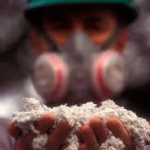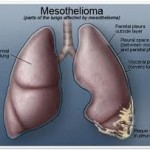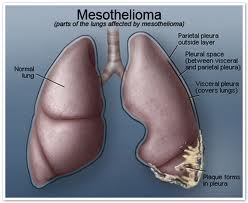4. Who is at risk for an asbestos-related disease?
Everyone is exposed to asbestos at some time during their life. Low levels of asbestos are present in the air, water, and soil. However, most people do not become ill from their exposure. People who become ill from asbestos are usually those who are exposed to it on a regular basis, most often in a job where they work directly with the material or through substantial environmental contact.
 Since the early 1940s, millions of American workers have been exposed to asbestos. Health hazards from asbestos fibers have been recognized in workers exposed in the shipbuilding trades, asbestos mining and milling, manufacturing of asbestos textiles and other asbestos products, insulation work in the construction and building trades, and a variety of other trades. Demolition workers, drywall removers, asbestos removal workers, firefighters, and automobile workers also may be exposed to asbestos fibers. Studies evaluating the cancer risk experienced by automobile mechanics exposed to asbestos through brake repair are limited, but the overall evidence suggests there is no safe level of asbestos exposure. As a result of Government regulations and improved work practices, today’s workers (those without previous exposure) are likely to face smaller risks than did those exposed in the past.
Since the early 1940s, millions of American workers have been exposed to asbestos. Health hazards from asbestos fibers have been recognized in workers exposed in the shipbuilding trades, asbestos mining and milling, manufacturing of asbestos textiles and other asbestos products, insulation work in the construction and building trades, and a variety of other trades. Demolition workers, drywall removers, asbestos removal workers, firefighters, and automobile workers also may be exposed to asbestos fibers. Studies evaluating the cancer risk experienced by automobile mechanics exposed to asbestos through brake repair are limited, but the overall evidence suggests there is no safe level of asbestos exposure. As a result of Government regulations and improved work practices, today’s workers (those without previous exposure) are likely to face smaller risks than did those exposed in the past.
Individuals involved in the rescue, recovery, and cleanup at the site of the September 11, 2001, attacks on the World Trade Center (WTC) in New York City are another group at risk of developing an asbestos-related disease. Because asbestos was used in the construction of the North Tower of the WTC, when the building was attacked, hundreds of tons of asbestos were released into the atmosphere. Those at greatest risk include firefighters, police officers, paramedics, construction workers, and volunteers who worked in the rubble at Ground Zero. Others at risk include residents in close proximity to the WTC towers and those who attended schools nearby. These individuals will need to be followed to determine the long-term health consequences of their exposure.
 One study found that nearly 70 percent of WTC rescue and recovery workers suffered new or worsened respiratory symptoms while performing work at the WTC site. The study describes the results of the WTC Worker and Volunteer Medical Screening Program, which was established to identify and characterize possible WTC-related health effects in responders. The study found that about 28 percent of those tested had abnormal lung function tests, and 61 percent of those without previous health problems developed respiratory symptoms. However, it is important to note that these symptoms may be related to exposure to debris components other than asbestos.
One study found that nearly 70 percent of WTC rescue and recovery workers suffered new or worsened respiratory symptoms while performing work at the WTC site. The study describes the results of the WTC Worker and Volunteer Medical Screening Program, which was established to identify and characterize possible WTC-related health effects in responders. The study found that about 28 percent of those tested had abnormal lung function tests, and 61 percent of those without previous health problems developed respiratory symptoms. However, it is important to note that these symptoms may be related to exposure to debris components other than asbestos.
Although it is clear that the health risks from asbestos exposure increase with heavier exposure and longer exposure time, investigators have found asbestos-related diseases in individuals with only brief exposures. Generally, those who develop asbestos-related diseases show no signs of illness for a long time after their first exposure. It can take from 10 to 40 years or more for symptoms of an asbestos-related condition to appear.
There is some evidence that family members of workers heavily exposed to asbestos face an increased risk of developing mesothelioma. This risk is thought to result from exposure to asbestos fibers brought into the home on the shoes, clothing, skin, and hair of workers. To decrease these exposures, Federal law regulates workplace practices to limit the possibility of asbestos being brought home in this way. Some employees may be required to shower and change their clothes before they leave work, store their street clothes in a separate area of the workplace, or wash their work clothes at home separately from other clothes.
 Cases of mesothelioma have also been seen in individuals without occupational asbestos exposure who live close to asbestos mines.
Cases of mesothelioma have also been seen in individuals without occupational asbestos exposure who live close to asbestos mines.
5. What factors affect the risk of developing an asbestos-related disease?
Several factors can help to determine how asbestos exposure affects an individual, including:
- Dose (how much asbestos an individual was exposed to).
- Duration (how long an individual was exposed).
- Size, shape, and chemical makeup of the asbestos fibers.
- Source of the exposure.
- Individual risk factors, such as smoking and pre-existing lung disease.
Although all forms of asbestos are considered hazardous, different types of asbestos fibers may be associated with different health risks. For example, the results of several studies suggest that amphibole forms of asbestos may be more harmful than chrysotile, particularly for mesothelioma risk, because they tend to stay in the lungs for a longer period of time.
6. How does smoking affect risk?
Many studies have shown that the combination of smoking and asbestos exposure is particularly hazardous. Smokers who are also exposed to asbestos have a risk of developing lung cancer that is greater than the individual risks from asbestos and smoking added together. There is evidence that quitting smoking will reduce the risk of lung cancer among asbestos-exposed workers. Smoking combined with asbestos exposure does not appear to increase the risk of mesothelioma. However, people who were exposed to asbestos on the job at any time during their life or who suspect they may have been exposed should not smoke.
